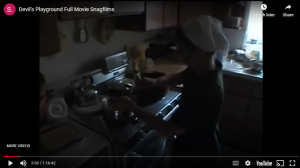Here’s the rough cut.
Jeremy Sauter Interview — Rough Cut
This is a REALLY rough cut, I still have work to do on it, but the skeleton is here~
-Jeremy Sauter
Interview Project – Rough Cut
Interview | Rough Cut
Blog for 10/18
My experience shooting the interview went pretty smoothly. I didn’t really have any trouble shooting the A roll and the B roll evidence. The hardest thing was trying to decide how exactly I should plan the whole thing, and what order. I just shot a a bunch of B roll and plugged it into Premiere Pro and just started editing from there and cutting out the stuff I didn’t need or like.
Other minor things such as filling in parts of the video with no audio- I just grabbed other clips that contained background noise and tried to match it with the previous clip so that the video doesn’t go silent as that would feel off. I also tried balancing the left and right audio levels the best I could since certain clips had different audio levels, as well as boosting a clip’s audio so it’s not too quiet compared to the others.
Visual Evidence in Devil’s Playground
Hello class, for this post I chose to talk about the scene where Velda shows us her wedding dress, my favorite scene from the movie. While the title of this clip was “Metephor not evidence”, I still think there are some very subtle but deliberate and effective visual ques that make this scene so visceral. First, I want to dissect what she is talking about. She begins by showing us her wedding dress; talking about how she left the church a few weeks before the wedding. She then rationalizes her boyfriend’s decision to stay saying, “He personally struggles with the loss of friendships that he would have had to deal with if he left with me”. In my opinion, this is also a reflection of her own sentiments toward her own leaving of the church. She then puts on the dress, indulges in a little reminiscence, and then says this very important line “Now that I have it on, I don’t see it that way anymore. I think I just see it as something that covers up the girl I really want to be”. This line to me tells me that her Amish past still haunts her presently, making it difficult to adapt to English culture. She still does not feel comfortable in her own skin. As far as answering the central question goes (Amish or English) this scene offers a third answer: Neither. This scene is about Velda’s physiological liminal space, it is about loneliness. Having said all that, by refraining from using any cutaways (as well as additional speakers and music), as any visual or auditory interjections of any kind would only serve to taint the visceral loneliness of the moment and break the flow of the scene, this scene effectively paints a visual picture of isolation. Thus she exists in a mental and physical state of isolation, with nothing but her own reflection to keep her company.
-Luca Wagner
Scott Daron Interview – Final Cut
Interview Final
Interview rough cut
Profile Rough Cut
Job Profile/Interview
Visual Evidence in Devil’s Playground
In documentaries, visual evidence is crucial for building a meaningful narrative from fragmented footage. Devil’s Playground explores the Amish youth experience during Rumspringa, asking the central question: will they embrace the Amish or English life? The visual evidence supports this narrative, whether staged to enhance the storytelling, or captured authentically.

One example of in-authentic but effective storytelling occurs at 1:08:30, when for a final interview one of the boys gets into a car and drives off. This scene feels staged because the subject would likely not have abandoned the cameraman, more likely they coordinated the shot to symbolize his return to the Amish community. Regardless, it can still be effective, especially for a more novice audience not looking for these things. It should also be noted that this is part of a series of scenes that wrap-up the stories of our side characters in an almost scripted/cheesy movie-like way.

Right before the previous clip, in another of these wrap-up segments at 1:05:48, a girl arrives home to prepare for college. The opening shot of her arriving, framed from behind the car, feels deliberate. It’s unlikely they spontaneously captured this moment, as the scene likely required advance planning to position the camera perfectly. These moments are small but they demonstrate how visual evidence is used not just to record events, but to structure a compelling story. While it may be in-authentic, they now had a establishing shot rather than skipping straight to her inside.

Finally, let’s look at an opposite example, where visual evidence is authentic potentially to the detriment of the film. For example at 3:50, the interior shots in the Amish homes are dimly lit to maintain realism. On a technical level, this reduces the quality of the film or simply our abilities to see things, but I would argue bringing in a bunch of studio lights would feel noticeably off, and even disrupt the natural behaviors of our subjects by messing with their environment.
Interview Assignment-Final
Blog 10/18
Shooting my job profile has been fun but challenging. I chose to film my dad, as he has the only career in the family I can do a profile on. Another challenge that arose was collecting visually appealing footage that works for the profile, as my dad is retired, and I cannot get footage of him actively working. To combat this issue, I was able to film old memorabilia that he still has, such as his old CHP motorcycle helmet from the 70s, and even an episode of an old “cops” style TV show featuring my dad. While it would have been better to film him actively working, I feel that the visual evidence I gathered still effectively shows what his job was all about.